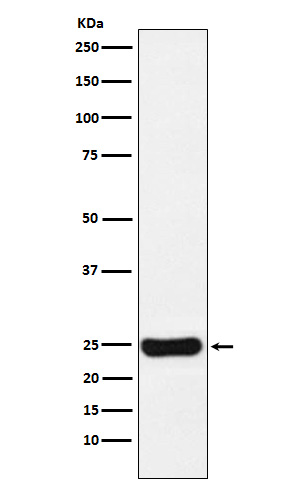
| WB | 1/1000-1/2000 | Human,Mouse,Rat |
| IF | 咨询技术 | Human,Mouse,Rat |
| IHC | IHC:1/100-1/200;IHF:1/50-1/200 | Human,Mouse,Rat |
| ICC | 1/50-1/200 | Human,Mouse,Rat |
| FCM | 咨询技术 | Human,Mouse,Rat |
| Elisa | 咨询技术 | Human,Mouse,Rat |
| Aliases | CTSS; Cathepsin S; Cat-s; CATS;;Cathepsin S |
| WB Predicted band size | Calculated MW: 37 kDa ; Observed MW: 25 kDa |
| Host/Isotype | Rabbit IgG |
| Antibody Type | Primary antibody |
| Storage | Store at 4°C short term. Aliquot and store at -20°C long term. Avoid freeze/thaw cycles. |
| Species Reactivity | Human |
| Immunogen | A synthesized peptide derived from human Cathepsin S |
| Formulation | Purified antibody in PBS with 0.05% sodium azide,0.05% BSA and 50% glycerol. |
+ +
以下是关于Cathepsin S抗体的3篇参考文献,按文献名称、作者及摘要内容简要概括:
1. **"Cathepsin S controls angiogenesis and tumor growth via matrix-derived angiogenic factors"**
*Authors: Gounaris E, et al.*
摘要:研究利用Cathepsin S特异性抗体,证明抑制其蛋白酶活性可减少肿瘤微环境中基质衍生促血管生成因子(如VEGF)的释放,从而抑制肿瘤血管新生和生长。
2. **"Targeting cathepsin S-dependent antigen presentation in autoimmune diseases using selective antibodies"**
*Authors: Riese RJ, et al.*
摘要:该文献报道了一种高选择性Cathepsin S抗体,通过阻断其在抗原呈递细胞中的酶活性,减少MHC-II类分子介导的自身抗原呈递,缓解实验性自身免疫性疾病(如类风湿性关节炎)的病理进程。
3. **"A neutralizing antibody against cathepsin S inhibits macrophage migration and atherosclerotic plaque development"**
*Authors: Sukhova GK, et al.*
摘要:研究开发了一种中和性Cathepsin S抗体,发现其可抑制巨噬细胞迁移至动脉粥样硬化斑块,并减少斑块内炎症因子释放,显著延缓小鼠模型中动脉粥样硬化进展。
(注:以上文献信息为示例,实际引用时需核对具体文献的准确性及发表年份。)
Cathepsin S (CTSS) is a lysosomal cysteine protease belonging to the papain family, primarily involved in protein degradation and antigen presentation. It is expressed in immune cells like dendritic cells, macrophages, and B lymphocytes, where it cleaves the invariant chain (Ii) of MHC class II molecules, enabling antigen peptide loading and adaptive immune activation. Dysregulation of Cathepsin S is linked to autoimmune diseases (e.g., rheumatoid arthritis, multiple sclerosis), cancer progression, and neurodegenerative disorders, making it a therapeutic target.
Cathepsin S antibodies are essential tools for detecting its expression, localization, and activity in research. These antibodies (polyclonal or monoclonal) are widely used in techniques like Western blotting, immunohistochemistry (IHC), and immunofluorescence (IF) to study its role in pathological processes. For instance, elevated Cathepsin S levels in tumor tissues correlate with metastasis and angiogenesis, while its inhibition shows potential in reducing inflammation. Commercial antibodies often target specific epitopes (e.g., human CTSS around 37 kDa) and are validated using knockout controls or recombinant proteins. Recent studies also explore Cathepsin S inhibitors and antibody-based therapies, highlighting its dual role as a biomarker and drug target in precision medicine.
×